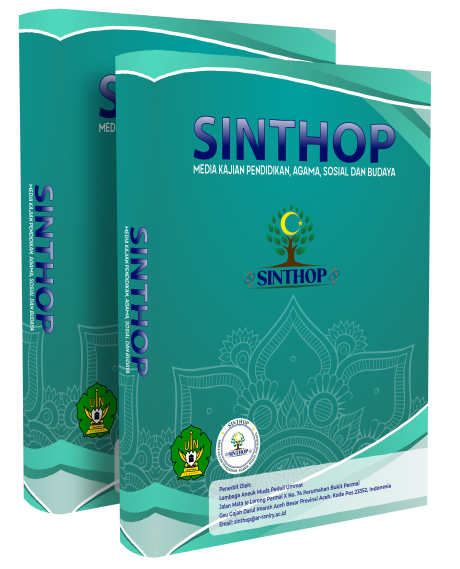The Naqshbandiyyah Al-Khalidiyyah Tariqah: Perspectives on Tawhid and Spirituality
DOI:
https://doi.org/10.22373/sinthop.v3i2.6096Keywords:
Tariqah, Al-Naqsyabandiyah Al-Khālidiyah, Tauhid, SpiritualityAbstract
The Al-Naqsyabandiyah Al-Khālidiyah Tariqah is one of the influential Sufi orders in the development of Islamic spirituality, with the significant role of the mursyid in guiding disciples toward closeness to God. This study aims to examine the existence of the mursyid in guiding disciples and analyze whether the concepts of tawasul and rabitah associated with the mursyid contradict the principles of tawhid and authentic Islamic teachings. The methodology used includes a literature review and textual analysis of classical works and contemporary literature related to the Al-Naqsyabandiyah Al-Khālidiyah Tariqah, the role of the mursyid, tawasul, and rabitah, as well as interviews with practitioners of the order to explore their perspectives. The findings indicate that the mursyid plays a vital role in the spiritual development of disciples in the Al-Naqsyabandiyah Al-Khālidiyah Tariqah. Additionally, tawasul and rabitah are not considered shirk in the context of this tariqah, but are seen as legitimate means to draw closer to Allah, provided they remain within the framework of tawhid. In conclusion, the existence of the mursyid is essential in this tariqah, and the practice of tawasul and rabitah can be accepted as long as it does not deviate from authentic Islamic teachings
References
Abdul Qadir Djaelani. (1996). Koreksi Terhadap Ajaran Tasawuf. Gema Insani.
Abu Abdillah Muhammad ibn Ahmad ibn Abi Bakar al-Qurtubi. (2006). Al-Jāmi’ li Ahkam al-Qur’ān. Muasasah al-Risālah.
Abu Bakar Atjeh. (n.d.). Pengantar Ilmu Tarekat.
Ahmad Warson Munawwir. (1997). Kamus Al-Munawwir. Pustaka Progresif.
Al-‘Ārif bi Allah Maulana Syaikh Muhammad Amin al-Kurdi al-Irbili. (n.d.). Dau’ al-Sirāj fi Fadl Rajab wa Qissah al-Mi’rāj. Mesir.
Al-‘Ārif bi Allah Maulana Syaikh Muhammad Amin al-Kurdi al-Irbili. (1995). Tanwīr al-Qulūb fi Mu’āmalāt ‘Allam al-Ghuyub. Dār al-Fikr.
Al-Imam Abd al-Ghani al-Nābulsi. (2008). Miftah al-Ma’iyah fi Dustur al-Naqsyabandiyah. Dār al-Judiyah.
Al-Syaikh Ibrahim al-Luqani. (1995). Syarah Tuhfah al-Murīd. Dār al-Kutub.
Fatonah, Y. (2021). Konsep Tawasul dalam Al-Qur’an: Kajian Komparatif Tafsir Klasik dan Kontemporer. Ulumul Qur’an: Jurnal Kajian Ilmu Al-Qur’an Dan Tafsir, 1(1), 1–18. https://doi.org/10.58404/uq.v1i1.8
Fauzan, M. H., Darsa, U. A., & Nani Sumarlina, E. S. (2023). KONSEP MURAQABAH: WACANA KEILMUAN TASAWUF BERDASARKAN NASKAH FATHUL ‘ARIFIN. KABUYUTAN, 2(1), 76–79. https://doi.org/10.61296/kabuyutan.v2i1.145
Husodo, P., & Welly. (2023). Perkembangan Tarekat Naqsyabandiyah Di Nagari Suayan, Kecamatan Akabiluru, Kabupaten Lima Puluh Kota Tahun 1984-2014. Jurnal Ceteris Paribus, 2(1). https://doi.org/10.25077/jcp.v2i1.21
Imron Abu Amar. (n.d.). Tharekat Naqsyabandiyah. Menara Kudus.
Khalid, I., Gulzar, S., & Amin, M. (2021). A Critical Review of Shamsuddin Azeemi’s “Murāqabah” through the Lens of The Qur’ān and Hadīth. Journal of Islamic Thought and Civilization, 11(1), 301–317. https://doi.org/10.32350/jitc.111.16
Martin Van Bruinessen. (1999). Tarekat Naqsyabandiyah di Indonesia. Mizan.
Maulana Syaikh Judah Muhammad Abu al-Yazid al-Mahdi al-Naqsyabandi. (2005). Al-Nafahāt al-Judiyah. Dār al-Judiyah, Syubra Khaimah.
Moh. Nazir. (1999). Metode Penelitian. Ghalia Indonesia.
Nur, F. M. (2021). Muraqabah dalam Perspektif Tarekat Naqsyabandiyah Al-Khalidiyah Al-Kurdiyah. Jurnal Pemikiran Islam, 1(1), 16. https://doi.org/10.22373/jpi.v1i1.10353
Sakhok, J., & Munandar, S. A. (2020). THE SUFI ORDER AND PHILANTHROPY:A CASE STUDY OF PHILANTROPHICAL ACTIVISM OF THE NAQSYABANDIYAH AL-HAQQANI SUFI ORDER IN INDONESIA. Teosofia, 8(1), 31. https://doi.org/10.21580/tos.v8i1.5299
Sodikin, S., Subandi Subandi, & Jaenullah Jaenullah. (2021). Nilai-Nilai Pendidikan Agama Islam dalam Pengamalan Tareqat Naqsabandiyah Khalidiyah. Berkala Ilmiah Pendidikan, 1(3), 98–102. https://doi.org/10.51214/bip.v1i3.273
Downloads
Published
How to Cite
Issue
Section
License
Copyright (c) 2024 Faisal M. Nur

This work is licensed under a Creative Commons Attribution-ShareAlike 4.0 International License.
Authors who publish in SINTHOP: Media Kajian Agama, Sosial dan Budaya agree to the following terms:
- Authors retain copyright and grant the journal right of first publication with the work simultaneously licensed Attribution-ShareAlike 4.0 International (CC BY-SA 4.0) that allows others to share the work with an acknowledgment of the work's authorship and initial publication in this journal.
- Authors are able to enter into separate, additional contractual arrangements for the non-exclusive distribution of the journal's published version of the work (e.g., post it to an institutional repository or publish it in a book), with an acknowledgment of its initial publication in this journal.
- Authors are permitted and encouraged to post their work online (e.g., in institutional repositories or on their website) prior to and during the submission process, as it can lead to productive exchanges, as well as earlier and greater citation of published work. (See The Effect of Open Acces)









.png)

.png)
.png)
.png)


